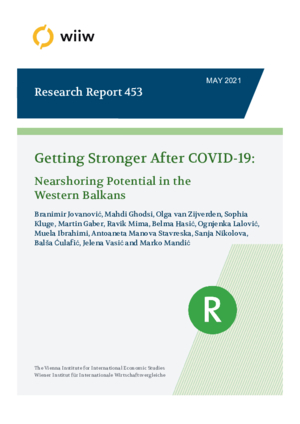Getting Stronger After COVID-19: Nearshoring Potential in the Western Balkans
Balša Ćulafić, Martin Gaber, Mahdi Ghodsi, Belma Hasić, Muela Ibrahimi, Branimir Jovanović, Sophia Kluge, Ognjenka Lalović, Marko Mandić, Ravik Mima, Sanja Nikolova, Antoaneta Manova Stavreska, Olga van Zijverden and Jelena Vasić
wiiw Research Report No. 453, May 2021
121 pages including 32 Tables, 39 Figures and 6 Boxes
This study aims to analyse whether and how the Western Balkan economies could benefit from near-shoring trends after the COVID-19 pandemic. It begins by discussing recent trends in foreign investment, and then presents an econometric analysis of determinants of foreign direct investment in the Western Balkans and East Asia. This is followed by a set of surveys, interviews and case studies, of different actors involved in global supply chains and investment, including foreign companies that have invested in the Western Balkans, foreign companies that are considering investing in the Western Balkans, local companies from the Western Balkans, and investment promotion agencies from these economies. The study concludes that Western Balkan economies can indeed benefit from near-shoring trends in the post-pandemic world, but would have to go beyond low labour costs in order to achieve that. Putting a focus on skilled labour, investment in education and training, improving infrastructure and governance would be the most important things to do.
This Publication has been replaced by a revised version on 24 June 2021.
Reference to wiiw databases: wiiw Annual Database, wiiw Monthly Database, wiiw FDI Database
Keywords: FDI, near-shoring, global value chains, Western Balkans, COVID-19
JEL classification: F21, E22
Countries covered: Albania, Bosnia and Herzegovina, CESEE, Kosovo, Montenegro, North Macedonia, Serbia, Western Balkans
Research Areas: International Trade, Competitiveness and FDI
